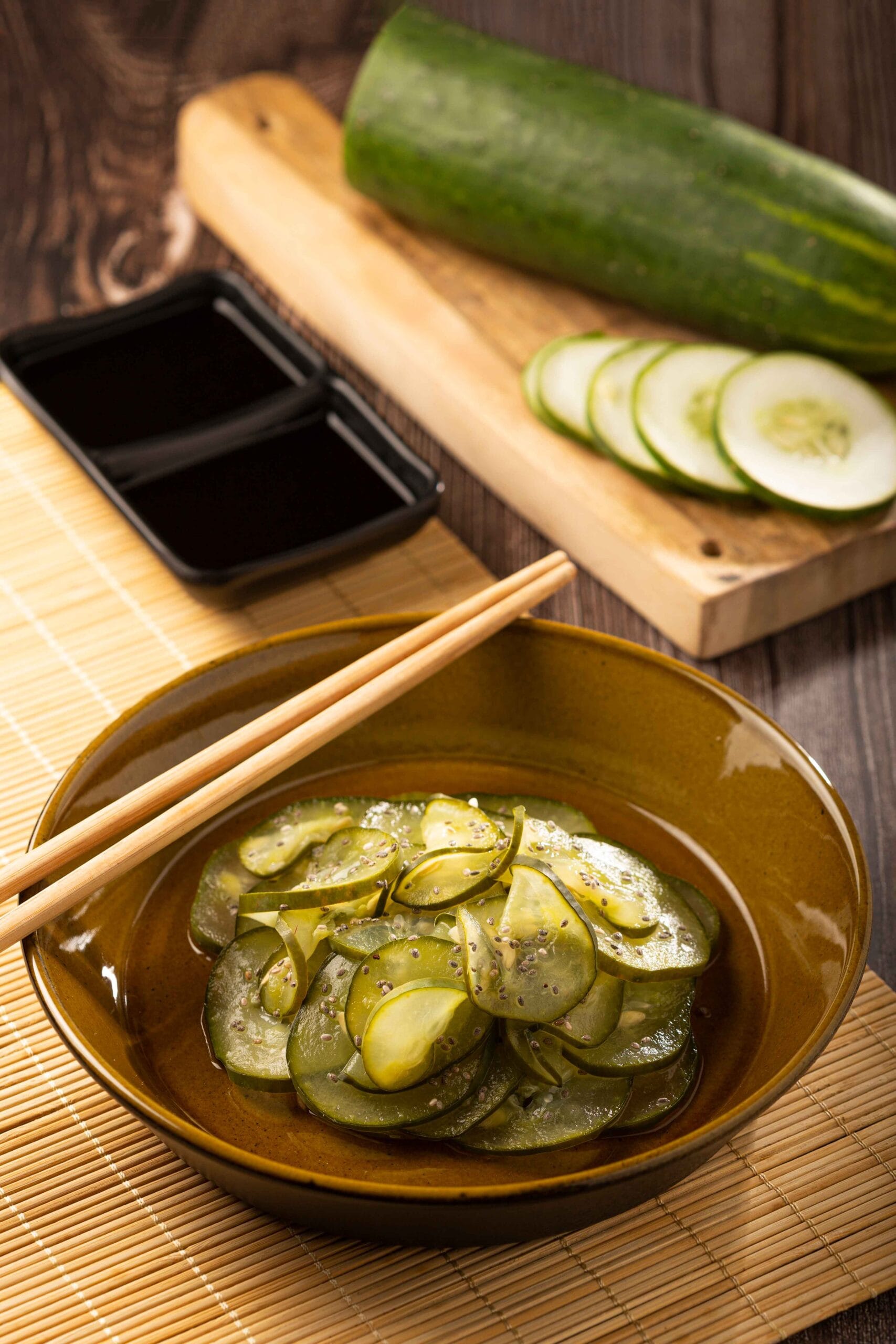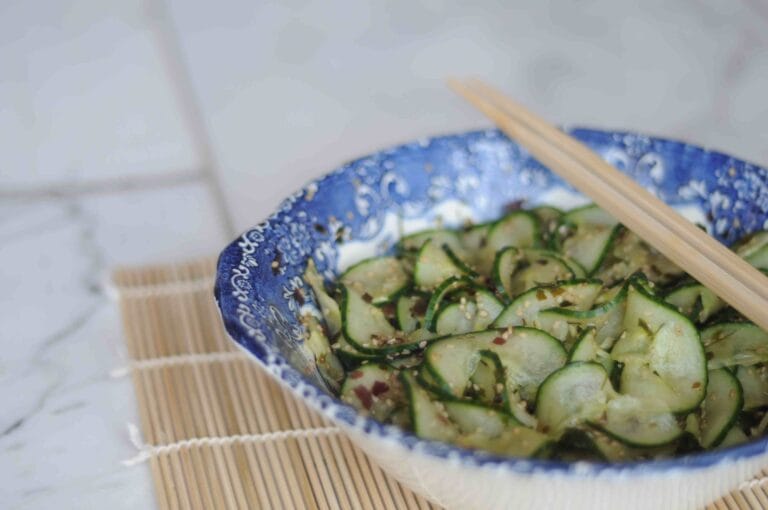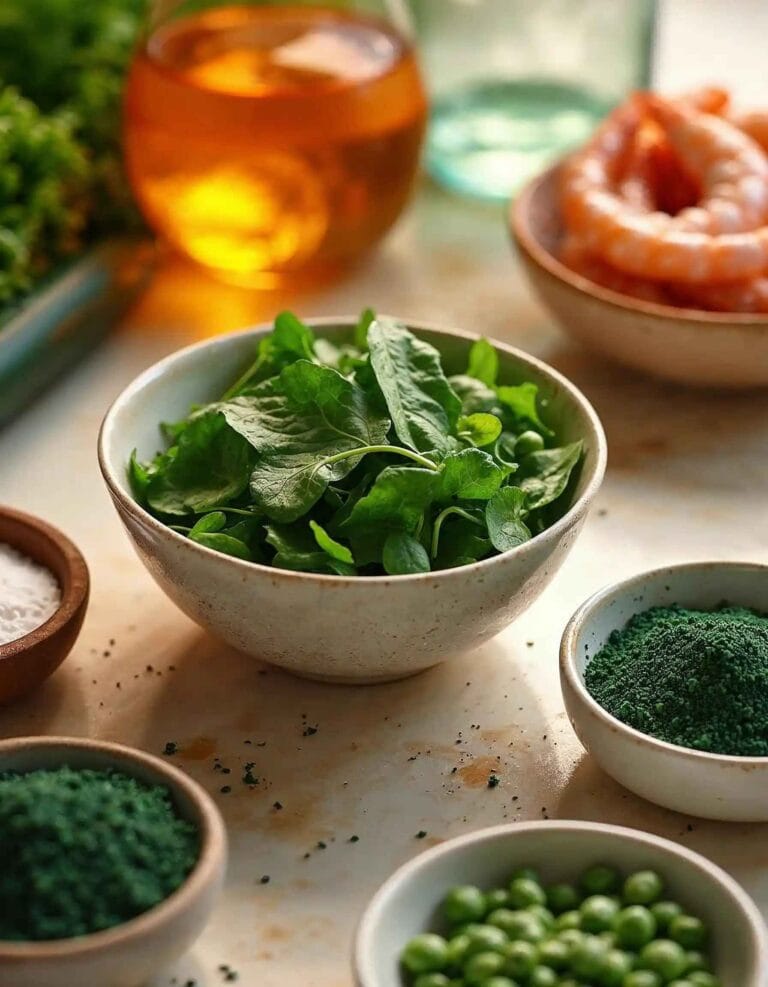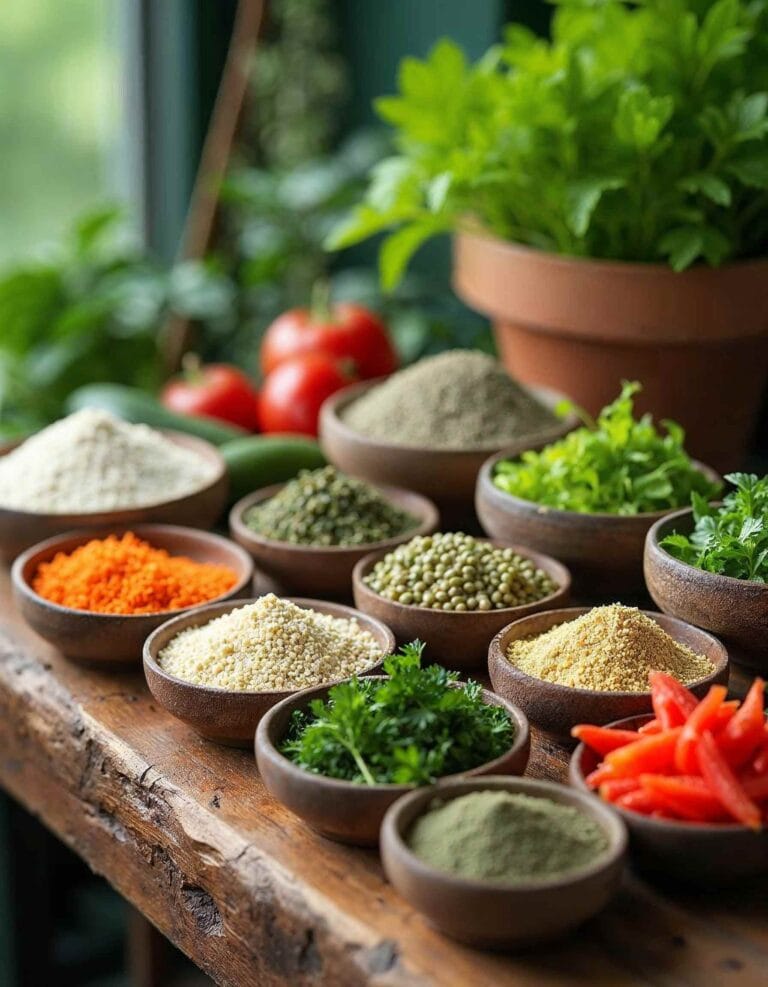Cucumber Kimchi Recipe: Easy, Refreshing, and Healthy Korean Side Dish
Kimchi, the iconic fermented side dish of Korea, holds a special place in the heart of the nation’s culinary heritage. Known for its tangy, spicy, and umami flavors, kimchi comes in many varieties, with Napa cabbage and radish being the most common. Among these, cucumber kimchi recipe, or oi sobagi, stands out for its refreshing taste and crunchy texture, making it an ideal dish for warmer seasons.
Unlike traditional cabbage kimchi, cucumber kimchi is prepared quickly and can be enjoyed almost immediately after preparation. It offers a delightful balance of spicy, salty, and mildly sweet flavors, enhanced by the natural juiciness of cucumbers. This recipe is perfect for those who love kimchi but prefer a lighter, fresher option.
Ingredients for Cucumber Kimchi
Essential Ingredients
To make authentic cucumber kimchi, you will need:
- Cucumbers (6-8 medium-sized): Choose firm, unwaxed cucumbers for the best texture.
- Coarse sea salt (1/4 cup): Used for salting the cucumbers.
- Korean red pepper flakes (gochugaru, 2-3 tablespoons): Provides the signature spicy kick.
- Garlic (4-5 cloves): Adds depth of flavor.
- Ginger (1 teaspoon, minced): Enhances the spice profile.
- Green onions (4 stalks): Adds a fresh, aromatic touch.
- Fish sauce (2 tablespoons): A key umami ingredient.
- Sugar (1 teaspoon): Balances the spice and saltiness.
- Water (as needed): For salting and washing the cucumbers.
Optional Add-Ons
- Carrot strips: For added crunch and color.
- Radish matchsticks: Traditional and flavorful addition.
- Sesame seeds: For garnish.
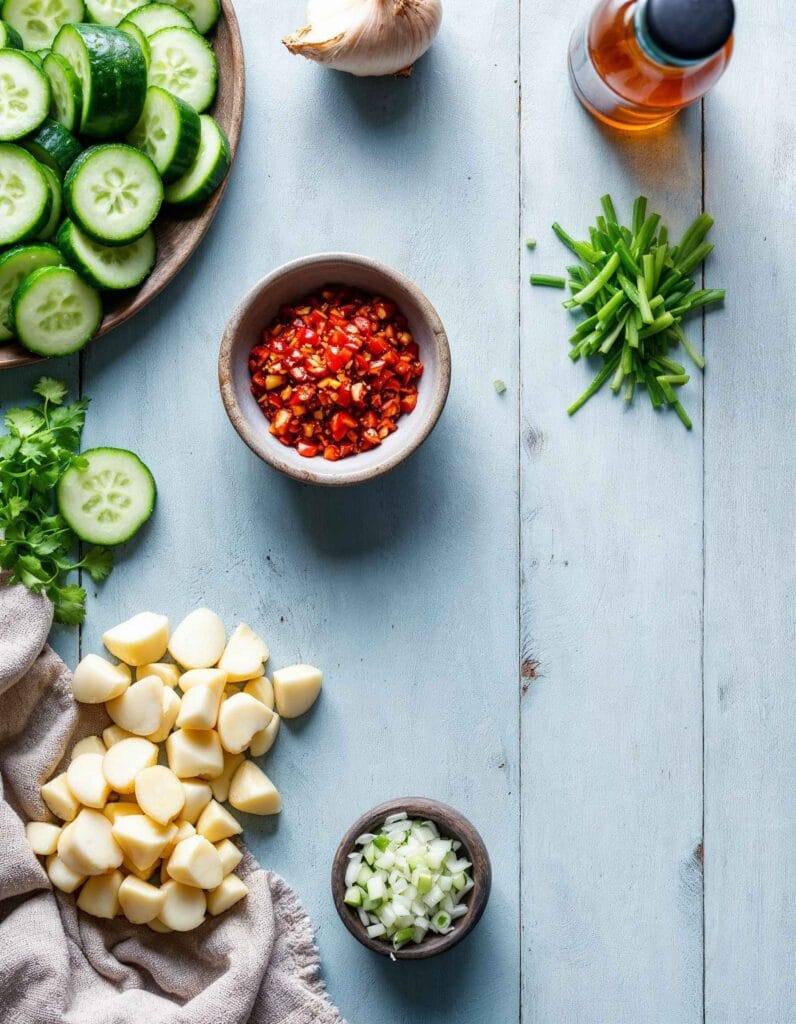
Step-by-Step Preparation of Cucumber Kimchi
Creating cucumber kimchi (oi sobagi) is a straightforward process that requires minimal effort. Follow these steps to ensure perfect results every time.
Prepping the Cucumbers
1: Choose the Right Cucumbers
Select fresh, unwaxed cucumbers that are firm to the touch. English cucumbers or Korean cucumbers are ideal due to their thin skin and crisp texture.
2: Clean and Cut
- Wash the cucumbers thoroughly under cold water to remove any dirt or impurities.
- Cut each cucumber into quarters lengthwise, leaving about an inch at the bottom intact so the pieces remain connected. This creates a “pocket” that will hold the seasoning paste.
3: Salt the Cucumbers
- Sprinkle coarse sea salt generously between the cucumber slices and on the outer surfaces. This process helps draw out excess moisture, making the cucumbers crunchier and more absorbent.
- Place the salted cucumbers in a colander or bowl and let them sit for about 30-40 minutes. Turn them occasionally to ensure even salting.
4: Rinse and Drain
- After the salting process, rinse the cucumbers under cold running water to remove the excess salt.
- Allow the cucumbers to drain in a colander for 10-15 minutes while you prepare the seasoning paste.
Making the Seasoning Paste
1: Prepare Ingredients
Gather the following:
- Minced garlic and ginger
- Sliced green onions
- Korean red pepper flakes (gochugaru)
- Fish sauce
- Sugar
- Optional add-ons like carrot or radish strips
2: Mix the Paste
In a mixing bowl:
- Combine 2-3 tablespoons of gochugaru (adjust based on your spice preference), minced garlic, ginger, fish sauce, and sugar.
- Add 1-2 tablespoons of water to create a paste-like consistency.
- Incorporate any optional ingredients such as carrots or radishes for added texture and flavor.
3: Taste and Adjust
Before applying the paste to the cucumbers, taste it to ensure the seasoning is balanced. Adjust the spice, salt, or sugar to your liking.
Filling the Cucumbers
1: Stuff the Seasoning Paste
- Using clean hands or a spoon, carefully spread the seasoning paste between the cucumber slices, ensuring the mixture coats each piece evenly.
- Be gentle to avoid breaking the cucumbers.
2: Assemble and Rest
- Place the stuffed cucumbers in an airtight container or a clean glass jar.
- Press down gently to remove any air pockets, which helps the fermentation process.
With the cucumbers now prepped and seasoned, they’re ready for fermentation.
The Fermentation Process for Cucumber Kimchi
Fermentation is the heart of kimchi-making, where the flavors deepen, and beneficial probiotics develop. Cucumber kimchi, unlike its cabbage counterpart, ferments relatively quickly due to its water content and delicate nature.
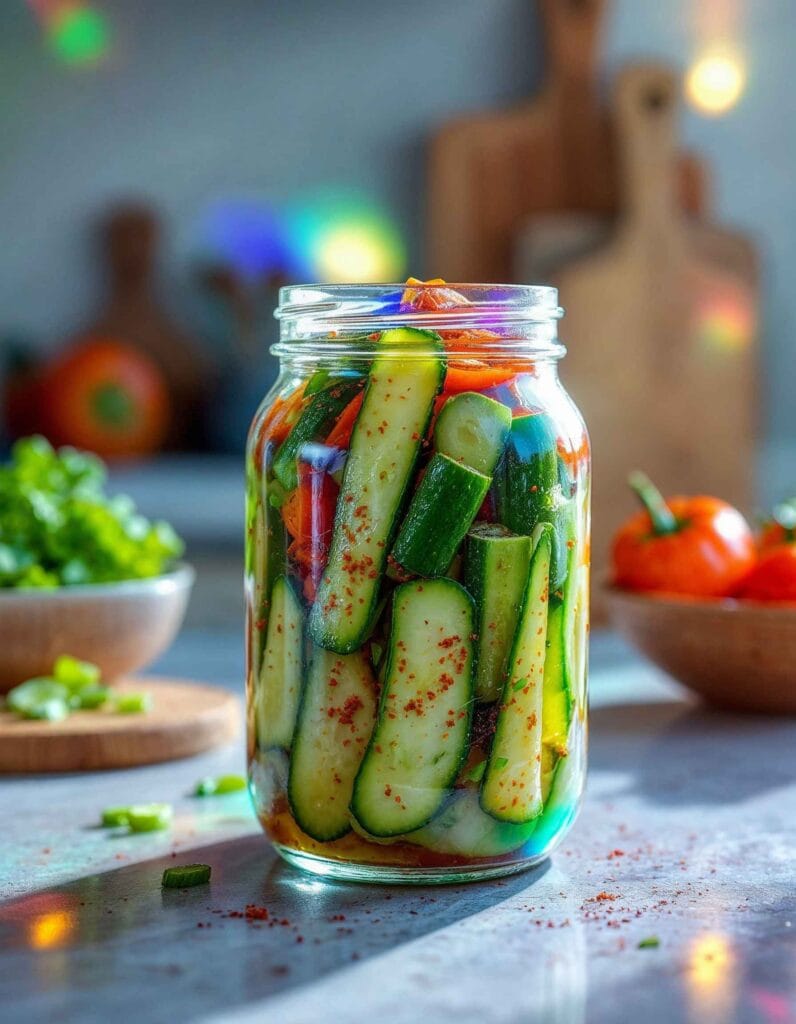
Tips for Optimal Fermentation
1: Choose the Right Container
- Use an airtight glass jar, a food-safe plastic container, or a traditional Korean clay jar (onggi).
- Ensure the container is thoroughly cleaned and dried to prevent contamination.
2: Pack the Cucumbers Tightly
- Place the stuffed cucumbers upright or layered snugly in the container to minimize air exposure.
- Press down gently to release any trapped air and create a uniform layer.
3: Prevent Overflow
- As the cucumbers ferment, they release water, which can cause overflow. Leave about an inch of headspace at the top of the container to accommodate this liquid.
How Long to Ferment
1: Initial Room-Temperature Fermentation
- Place the container in a cool, dark spot at room temperature for 6-12 hours. This kickstarts the fermentation process.
- Check periodically to ensure the cucumbers are submerged in their juices. If not, press them down gently.
2: Refrigeration
- After the initial fermentation, transfer the container to the refrigerator to slow down the fermentation process and preserve the freshness of the cucumbers.
- Allow the cucumber kimchi to ferment in the fridge for 1-2 days for a mild flavor. For a more intense, tangy profile, let it ferment for up to a week.
3: Monitor and Taste
- Check the cucumbers daily to gauge the fermentation progress. Taste a piece to determine if the flavor and texture meet your preference.
- Once the desired flavor is achieved, your cucumber kimchi is ready to enjoy.
Storing Fermented Cucumber Kimchi
Step 1: Proper Storage
- Keep the cucumber kimchi in an airtight container in the refrigerator to maintain its freshness.
- The kimchi is best consumed within 2 weeks for optimal texture and taste, although it can last longer if stored properly.
Step 2: Signs of Over-Fermentation
- Over time, cucumber kimchi may become too sour or mushy. While it is still safe to eat, it’s best to use over-fermented kimchi in stews or as a flavoring agent in recipes.
With your cucumber kimchi fully fermented, it’s time to explore creative ways to serve and enjoy this versatile dish.
Serving Suggestions for Cucumber Kimchi
Cucumber kimchi is a versatile dish that can be enjoyed in many ways. Its refreshing crunch and bold flavors make it a delightful addition to both traditional and modern meals. Here are some creative serving ideas to inspire your culinary adventures.
Traditional Pairings
Serve as a Side Dish (Banchan)
- Cucumber kimchi is often served as one of the many small side dishes (banchan) that accompany a traditional Korean meal.
- Pair it with steamed rice, Korean grilled meats (galbi or bulgogi), or hearty stews like kimchi jjigae for a complete and balanced meal.
Complement Soups and Noodles
- Add cucumber kimchi to cold noodle dishes like naengmyeon for a refreshing twist.
- Serve it alongside spicy Korean soups like tteokguk (rice cake soup) or doenjang jjigae (soybean paste stew) to balance out the heat and richness.
Modern Ways to Enjoy Cucumber Kimchi
As a Topping
- Use cucumber kimchi as a vibrant topping for grain bowls, salads, or avocado toast.
- Add it to tacos or burgers for a zesty, spicy crunch.
In Wraps and Rolls
- Include cucumber kimchi in Korean-style lettuce wraps (ssam) with grilled protein and rice.
- Incorporate it into sushi rolls or rice paper wraps for a fusion take on traditional kimchi flavors.
As an Ingredient
- Chop it finely and mix it into fried rice for an extra layer of flavor.
- Use it as a filling for omelets or savory pancakes like jeon.
Beverage Pairings
Traditional Korean Drinks
- Pair cucumber kimchi with makgeolli (Korean rice wine) or soju for a classic Korean dining experience.
Refreshing Non-Alcoholic Options
- Serve with iced barley tea (boricha) or green tea to cleanse the palate and complement the kimchi’s spiciness.
Creative Serving Tips
Add a Gourmet Touch
- Garnish cucumber kimchi with toasted sesame seeds or chopped scallions for added flavor and visual appeal.
Presentation Matters
- Arrange the cucumber kimchi neatly on a small plate or in a shallow bowl, emphasizing its vibrant colors and textures.
These serving suggestions showcase the versatility of cucumber kimchi, whether you’re aiming for authenticity or experimenting with new culinary trends.

Health Benefits of Cucumber Kimchi
Cucumber kimchi is not just a flavorful side dish; it’s also a nutritional powerhouse packed with health benefits. Thanks to its fresh ingredients and fermentation process, cucumber kimchi can be a valuable addition to a balanced diet.
Probiotics and Gut Health
The Role of Fermentation
- Fermentation is the key to kimchi’s health benefits. During this process, beneficial bacteria like Lactobacillus develop, turning cucumber kimchi into a natural source of probiotics.
- Probiotics improve gut flora, aiding digestion and enhancing nutrient absorption.
Improved Digestive Health
- Regular consumption of probiotic-rich foods like cucumber kimchi can alleviate digestive issues such as bloating and constipation.
- The combination of fiber from cucumbers and gut-friendly bacteria supports a healthy digestive system.
Nutritional Value of Cucumber Kimchi
Low in Calories, High in Nutrients
- Cucumbers are low in calories and high in water content, making cucumber kimchi a hydrating and weight-friendly food.
- Ingredients like garlic, ginger, and red pepper flakes add antioxidants and anti-inflammatory properties.
Vitamins and Minerals
- Rich in vitamin C, cucumber kimchi helps boost the immune system.
- Contains essential minerals like potassium, which aids in maintaining healthy blood pressure levels.
Potential for Weight Management
- The low-calorie profile and satiating properties of cucumber kimchi make it a great addition to weight-loss diets.
- Capsaicin, found in red pepper flakes, may boost metabolism and fat burning.
Detoxifying Properties
Hydration and Detoxification
- Cucumbers are naturally hydrating and help flush out toxins from the body.
- The fermentation process enhances the detoxifying properties of the dish by introducing beneficial enzymes.
Strengthened Immune System
Antioxidants at Work
- Garlic, ginger, and red pepper flakes are potent sources of antioxidants, which help neutralize free radicals and reduce oxidative stress.
Anti-Inflammatory Effects
- Ginger and garlic have well-documented anti-inflammatory benefits, which can help reduce chronic inflammation and support overall health.
Other Potential Benefits
Improved Heart Health
- The probiotics in cucumber kimchi may help lower cholesterol levels and improve cardiovascular health.
Enhanced Skin Health
- The hydration from cucumbers and the antioxidant properties of other ingredients can contribute to glowing, healthy skin.
Blood Sugar Regulation
- Fermented foods like cucumber kimchi may have a positive effect on blood sugar levels, making it a potential addition for those managing diabetes.
Cucumber kimchi combines culinary enjoyment with a host of health benefits, proving it’s more than just a delicious dish.
FAQS:
How long is cucumber kimchi good for? (Reddit-style Answer)
Cucumber kimchi is best consumed within 2 weeks of preparation when stored in an airtight container in the refrigerator. Over time, it will continue to ferment and may become too sour or lose its crunchiness. While it’s still safe to eat for up to 3-4 weeks, its texture and taste are most enjoyable in the first two weeks. If it becomes overly fermented, you can repurpose it for recipes like stews or fried rice.
What is cucumber kimchi good for?
Cucumber kimchi is a versatile side dish that complements a variety of meals. It is perfect for:
- Enhancing the flavor of plain steamed rice with its tangy and spicy profile.
- Adding crunch and zest to Korean grilled meats (galbi, samgyeopsal).
- Pairing with soups, stews, and noodle dishes for a refreshing balance.
- Serving as a low-calorie snack rich in probiotics, vitamins, and antioxidants for digestive and overall health.
Its light, hydrating qualities also make it an excellent choice for summer meals.
What are popular Korean side dishes?
Korean cuisine is renowned for its wide array of side dishes (banchan). Popular options include:
- Napa Cabbage Kimchi (baechu kimchi): The most iconic variety of kimchi.
- Pickled Radish (danmuji): Sweet and tangy yellow pickled radish, often served with Korean fried chicken.
- Seasoned Spinach (sigeumchi namul): A lightly seasoned spinach dish.
- Soy-Glazed Potatoes (gamja jorim): Sweet and savory braised potatoes.
- Egg Rolls (gyeran mari): Fluffy rolled eggs with vegetables.
- Spicy Rice Cakes (tteokbokki): Chewy rice cakes in a spicy gochujang sauce.
Cucumber kimchi is one of these beloved side dishes, often enjoyed for its quick preparation and unique flavor.
How long does cucumber kimchi ferment?
Cucumber kimchi ferments quickly compared to cabbage kimchi. The fermentation process typically unfolds as follows:
- At room temperature: It can start fermenting within 6-12 hours for immediate consumption.
- In the refrigerator: After transferring to the fridge, allow 1-2 days for a mild, tangy flavor. For a stronger fermented taste, let it sit for up to 5-7 days.
Since cucumbers are more delicate, they ferment faster but are best enjoyed fresh to retain their crispness.
Conclusion
Cucumber kimchi, or oi sobagi, is a delightful twist on traditional kimchi, offering a refreshing, spicy, and crunchy side dish that’s perfect for any occasion. Its quick preparation, minimal fermentation time, and vibrant flavor profile make it a popular choice for beginners and seasoned kimchi enthusiasts alike. Whether enjoyed alongside Korean classics like grilled meats and stews or incorporated into modern dishes like grain bowls and tacos, cucumber kimchi is as versatile as it is delicious.
Not only does this dish tantalize your taste buds, but it also provides a host of health benefits, from probiotics that support gut health to antioxidants that boost immunity. By following this recipe, you can create your own batch of cucumber kimchi and explore its rich flavors while reaping its nutritional rewards.
Dive into the world of Korean cuisine with cucumber kimchi as your starting point. It’s more than just a side dish—it’s a gateway to the bold and vibrant culinary culture of Korea. So, grab your cucumbers, spice up your kitchen, and enjoy the wonderful journey of fermentation.

